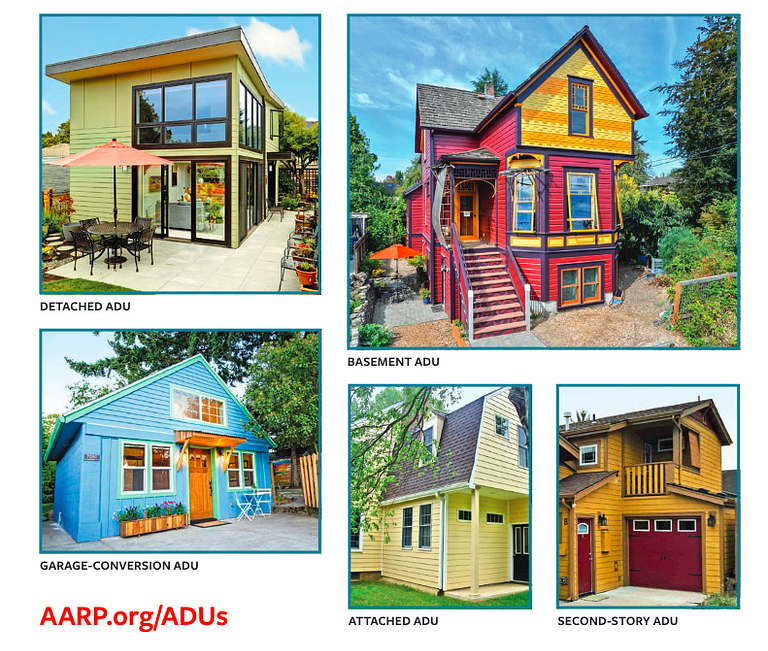
AARP
ADU examples, as pictured by the AARP.
A city proposal to let landlords build extra apartments on their properties met resistance from an aldermanic committee wary of removing an existing owner-occupant restriction.
The Board of Alders Legislation Committee decided on Tuesday night to “take no action” on the Elicker administration’s proposal, providing another opportunity for a public hearing and further deliberations.
City zoning and economic development officials had pitched an ordinance amendment that would expand eligibility for property owners to create an extra apartment — formally called an Accessory Dwelling Unit, or an ADU — either within or next to an existing house. City officials have pitched this proposal as part of a broader effort to increase the supply of apartments amid a housing shortage widely considered to be a cause of higher rents.
Alders originally legalized as-of-right ADUs in a 2021 ordinance, which built in substantial restrictions. The current ordinance permits ADUs carved from existing structures on the property, such as an attic, basement, or garage. It does not permit as-of-right development of ADU apartments that would require new construction. ADUs could only be built on lots with an area of at least 4,000 square feet, per that law. And only homeowners who live on the property are allowed to establish an ADU.
Since the ordinance passed, no ADUs have actually been built without zoning relief.
The proposed amendment currently on the table would enable new construction of ADUs, allow landlords to build ADUs on properties that aren’t their own homes, and remove minimum lot size requirements.
Any new construction would have to be at least 5 feet away from the property line and, if built on ground level, comply with “Type B” accessibility standards that would make the apartment more easily adaptable to physical disabilities.
City Plan Director Laura Brown framed the amendment as a small step toward increasing affordable rental options in New Haven, by making it easier for property owners to add to the supply of housing and keep pace with demand. She said the city had always planned for landlord-developed ADUs as part of the next phase of an ADU rollout. “The ADU ordinance is not going to solve the housing crisis,” she said. “It’s one piece of the puzzle.”

Laura Glesby Photo
City Plan Director Laura Brown and Assistant Director of Comprehensive Planning Esther Rose-Wilen.
The proposed removal of an owner-occupancy requirement for ADUs has been divisive among other housing and development leaders in the city.
The city’s public housing and largest affordable housing provider, Elm City Communities, has expressed support for the removal of homeownership requirements for ADU construction in order to promote more affordable housing in its 2023 Breaking Ground report.
But when the City Plan Commission reviewed the proposal, commissioners balked at the plan to allow ADUs beyond owner-occupied properties, concerned about the potential for landlords to build more apartments without maintaining safe or habitable conditions. The commission issued a recommendation that alders maintain the restriction of ADU construction to homeowners.
On Tuesday, Dixwell Alder Jeanette Morrison echoed this concern. “I envision all these ADUs popping up, popping up, and people not being in the healthiest situations,” she said. The city may not have enough housing code inspectors to keep pace. “How do we handle that if we don’t have the bodies?”
In response, Brown and other city staffers emphasized that they do not expect the ADU amendments to result in a massive stream of new housing.
Brown also argued that concerns about living conditions in ADUs have to do with housing code enforcement, not zoning laws.
“The maintenance issue is something that goes over and above the ADU requirement,” as an issue that the city should address across all kinds of housing units, she said.
The Elicker administration has proposed hiring more Livable City Initiative (LCI) housing code inspectors in the next city budget. Brown noted that ADUs built on non-owner occupied lots would be subject to LCI rental inspections.
Brown said she also anticipated questions about how ADUs might be used as “short-term rentals” for vacationers, such as AirBnBs. She argued that AirBnBs, too, should be regulated separately from this zoning amendment. The city does not currently have any restrictions on short-term rentals, but Brown said her department is looking into possible regulations.
Meanwhile, Economic Development Administrator Mike Piscitelli said his department is researching ways the city can make ADU construction more financially accessible for low-to-moderate income homeowners, potentially through loan programs or utility deals.
Westville Alder Adam Marchand, who also serves on the City Plan Commission, asked how ADUs in other cities have affected the property values of neighboring homes. Is it possible, he wondered, that the ADU policy could lead to “higher tax values and not lower rents? Could it actually make this problem worse?”
Most of the available data, Brown replied, comes from the West Coast. Some areas saw an increase in property values after ADU policies were enacted, while others saw a decrease or no significant impact. “It’s sort of uneven and unknown, and we haven’t done this before in Connecticut,” she said.
"Dangerous" Landlord Boost? Necessary Housing Step?

Fernando Pastor and Kelly Blanchat offer clashing perspectives on the ordinance amendment.
Public testimony revealed mixed support for the proposal.
Beaver Hills homeowner Kelly Blanchat said that several of the houses in her neighborhood have been flipped and resold to large landlords, and that the upkeep of those houses have quickly declined. Allowing landlords to build ADUs would lead to “a more dangerous housing market,” she said.
Meanwhile, local architect Fernando Pastor said he has multiple clients who would like to build an ADU, yet have faced hurdles with the current regulation. “The only way to reduce rent is to get more housing,” he said.
Downtown Alder Eli Sabin pointed out that the ordinance amendment would still require buildings to take up no more than 30 percent of the entire property’s area. The 30 percent floor coverage cap, combined with the minimum ADU area of 400 square feet, could inhibit some property owners whose houses already take up close to 30 percent of their lots from building ADUs.
In his testimony, Pastor said he’s witnessed firsthand how the 30 percent floor coverage cap can be a roadblock for homeowners.
Alders decided to take more time to consider that restriction, along with the owner-occupancy requirement and the other concerns raised during the meeting. Amity/Westville Alder Richard Furlow, who was serving as an interim committee chair that evening, decided to postpone making a recommendation on the proposal — meaning that another public hearing will take place.
For a deeper dive, check out…
• The proposed ordinance amendment
• A memorandum with the City Plan Department’s research on ADUs
• Elm City Communities’ Breaking Ground report
• The City Plan Commission’s recommendation to alders











5 feet from the property line is too close!! It will destroy home ownership, especially for the poorer home owner that won’t be able to pivot with their own construction. Imagine a building within 5 feet on both sides of your property. It will destroy privacy in your home, in your kitchen, in your bedroom and in your backyard. This is so short sided it is astonishing. New Haven is crushing families!